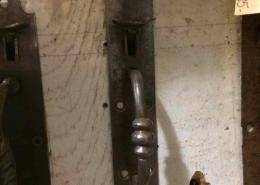



Primitive Latches – fortifications universally comprised a repurposed bar placed across the portal and secured at both ends. Designs permitting the bar to slide aside and miniaturization of the device created the ‘slide-bolt’ and enabled this timeless and sometimes decorative locking system to be affixed to the door.
By anchoring one end of the bar whilst allowing it to swivel the bar could be lifted in and out of its keeper. This revelation birthed the first thumb-latch. Blacksmiths created highly imaginative designs- heart, spade, tulip, cannonball, and swordfish to name a few.
1700s – Hundreds of years passed passed until the 18th century. During the reign of George II (1727-1760) a Georgian blacksmith passed a spindle through a door, a plate mounted on the inside of the door, and a cam abutting the plate. To the plate he then attached one end of a latch-bar, with the latch-bar resting on the cam such that turning the knobs on either end of the spindle rotated the spindle, and in turn the cam, thus raising the latch-bar.
This was a EUREKA moment.
1800s – During the ensuing Regency period, in approximately 1820, John Carpenter’s designs enclosed the mechanism in a box. Fast forward fifty years and find that during the mid 19th century the Victorians modified the mechanism’s rotary motion to withdraw, rather than lift the latch… another milestone.
In 1840 the industrial revolution was beginning. It celebrated mass production and heralded the demise of individualized hand wrought hardware. At this point in time the latch was buried (mortised) into the edge of the door.
1900s – Hardware thus became totally reliant on its trimmings for aesthetics. Mass marketing and early consumerism entrenched 20th century style trends like Art Deco, Art Nouveau, Arts and Crafts and a plethora of revival styles.
For more information on hardware, check out our blog post entitled “Three Centuries Of Door Hardware“.